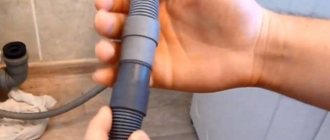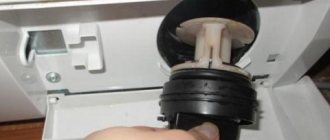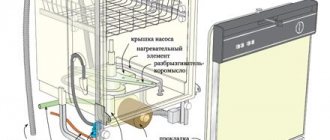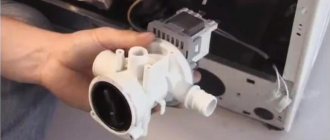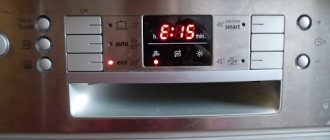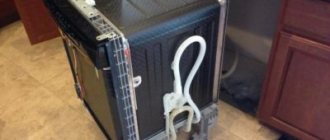How does the AquaStop system work?
Part of the dishwasher's leakage protection system is located outside it, while other components are inside.
From the outside you can see:
- Water supply hose located in another, more durable, protective hose.
- A block of two electromagnetic, absorbent or mechanical valves built into the hose
Most modern cars have solenoid valves.
One of the valves is working , the other is a safety valve.
Valves, in fact, are devices that block the passage of water through the hose into the equipment.
Inside the lower part of the case there are:
- Pallet.
- Control float.
- Security wire.
- Reset button.
1. Solenoid valve block 2. Water supply hose 3. Tray 4. Control float 5. Safety wire 6. Reset button
Operating principle of AquaStop dishwashing equipment:
- When the dishwasher is connected to the network, the safety valve opens. Opening occurs due to the supply of voltage.
- When the unit starts up (when you press the “Start” button and the washing begins), the operating valve opens.
- Water enters the machine.
- If water leaks somewhere, it will certainly end up in the pan of the machine.
- As water accumulates in the pan, it raises the control float.
- If the permissible water level in the pan is exceeded (average volume 0.2 liters), the float opens the electrical contact of the safety wire.
- The voltage supply to the safety valve is stopped. It closes, shutting off the water.
AquaStop worked! The operation of the dishwasher has been stopped for the safety of the unit itself and its owners. The water already in the machine is pumped out automatically and drained into the sewer.
If you have a dishwasher with a display, the corresponding error code . If without it, the lights will flash , the combination of which can also be deciphered (if you look at the instructions) as the activation of protection against water leaks.
In rare cases, AquaStop works without displaying an error code on the control panel.
Functions of the Aquastop system
If your Electrolux, Hansa, Siemens dishwasher is equipped with partial protection, most likely it is the inlet hose with Aquastop. It is equipped with a casing and a mechanism for shutting off the water. When a leak occurs or the hose is damaged, the valve is activated and the water flow is stopped.
Aqua-Control will protect the system in case of water hammer. Whereas a system without protection may not withstand high pressure.
In the new PMM models “Bosch”, “Ariston”, “Hansa”, “Electrolux”, “Krona” you can find an improved device: in addition to the inlet hose, a float sensor is installed in the pan. How this scheme works:
- You plug the machine into the network.
- The Aquastop valve receives a signal and opens.
- As soon as you press the "Start" button, the fill valve membrane opens.
- Water enters the bunker.
- If a leak occurs, water penetrates into the PMM pan.
- When the critical point is reached, the float sensor floats up.
- The valve closes and the water flow stops.
The internal float is called “Aquacontrol”.
Today, more and more manufacturers are trying to produce PMMs with full “Aquastop”. This is a guarantee not only of your safety, but also of your neighbors. Thanks to the system’s functions, you can safely run your appliances at night or go away on business while the dishwasher is running.
How to disable Aquastop and restore the dishwasher? Once the problem has been resolved, press the reset key and the machine will be ready to use again.
Design and functional features
In world practice, any protection against leaks is called Aqua-Stop or Aqua-Control. In principle, this is an ordinary water supply hose for household appliances, only enclosed in a special protective casing with a device that shuts off the water in case of unforeseen circumstances: a break in the hose, its leakage due to a crack, etc. Thus, the built-in protection system protects you from unwanted flooding. Its task is to immediately turn off the water supply to household appliances, dishwashers or laundry aids to prevent water from leaking onto the floor.
Many homeowners do not even realize that the pressure in the plumbing system is quite high, and water hammer - a sudden increase in internal pressure - occurs frequently. You simply cannot do without a reliable hose protection system.
The standard Aquastop system consists of the following main parts:
- block of mechanical or solenoid valves;
- water inlet hose into the device;
- pallet;
- float;
- safety wire;
- excess water release button.
Aquastop device: A - Solenoid valve, C - inlet hose B - control cable D - Leaks (water hoses)
All models - in one catalog!
When choosing branded equipment in regular stores, you can only find some models. An online store specializing in large and small household appliances Smeg is a godsend for lovers of modern dishwashers and washing machines, hobs, refrigerators, ovens, stoves, hoods, and sinks. And if you already have enough large household appliances, choose a beautiful toaster, kettle or mixer in retro style!
All products presented on the site are covered by the manufacturer's warranty! Order any model with delivery to any region of the country right now!
Types and device
The design may vary. Manufacturers have developed several different methods, which have their own advantages and disadvantages. The inlet hose protection is:
- Mechanical. It is used quite rarely, but is still found in inexpensive Bosch models. The design includes a spring and a valve. When a leak occurs, the pressure rises, the spring reacts to this and the valve closes.
A huge disadvantage of mechanical Aquastop is that it is unable to catch small leaks. Without proper control, they can lead to flooding.
- Using an absorbent. The method is somewhat similar to the previous one. If you disassemble the structure, you will see a valve, a plunger, a spring and an absorbent sponge. When a leak occurs, water enters a reservoir containing an absorbent, which swells and triggers the spring. That, in turn, blocks the entrance to the hose with a valve.
The disadvantage of the absorbent system is very significant - it is disposable. If AquaStop works once, you will not be able to unlock and reuse the item. We'll have to completely change the defense.
- Electrical or electromagnetic. The hose is equipped with one or two valves and a protective sheath. Flowing down the casing, the water immediately enters the pan. There the float is activated and blocks the valve.
Interesting! The electronic and absorbent type system works in 99% of cases. There is only an 8 out of 1000 chance that your car will leak. Mechanical protection works in 85%, that is, the chances of a leak are 147 to 1000.
Mechanical method of protection
It is not used so often, for example, on inexpensive Bosch dishwashers. The device consists of a spring with a valve. The spring is designed for a strictly defined operating pressure: when there is a leak, it immediately drops, the spring is triggered, and the flow of water is blocked by the valve. The disadvantage of this method is that the system does not respond to small leaks, only floods.
According to statistics, the mechanical appearance of the Aquastop system can recognize only about 150 leaks out of a thousand, that is, quite a bit. The mechanical shut-off device located on the drain line, once activated in the event of a leak, is not suitable for reuse; the entire hose must be replaced.
Absorbent protection
This system is more common and is used more often. Its operating principle is simple: when there is a leak, water flows into a container with an absorbent; as a result of contact with water, the absorbent begins to swell and expand, as a result, it helps to stop the supply of water to the “dishwasher” using the valve. A device using an absorbent is equipped with a spring or plunger. The disadvantage of the system is that the absorbent, after increasing in size, hardens and blocks the valve. It is impossible to use it in the future; the hose also needs to be changed.
The purpose of existence and the principle of operation of the system?
Not all consultants understand how aquastop works. When describing a dishwasher, store managers will definitely mention this function, but only a few will be able to explain the principle of its operation. So why is such a system necessary in a dishwasher?
The pipes through which water is supplied to high-rise buildings have very high pressure. Cases of water hammer are also common. Therefore, a leak may unexpectedly occur, and then the liquid will begin to leak out of the equipment. The Aquastop system was invented to protect the dishwasher from leaks. Special sensors immediately react to a gust and block the operation of the device.
The main task of the aquastop is to detect a leak in time, stop the flow of water into the dishwasher and drain the liquid from the system.
The operating principle of the aquastop is simple. Events develop as follows:
- water flows out of the appliance and collects in the tray provided under the dishwasher;
- the float rises when the water level reaches 200 ml;
- the electric sensor transmits a signal to the control board;
- the “brain” stops the dishwasher and starts the drain pump;
- water is pumped out of the system.
If a leak occurs at the stage of water intake, then the main “concerns” fall on the shoulders of the inlet hose. If violations are detected, a special valve shuts off the water flow. As a result of such measures, liquid ceases to be drawn into the system.
The Aquastop system, according to statistics, helps to avoid damage from leaks in 992 cases out of 1000. The likelihood that the option will not work is negligible. However, protection cannot be 100% guaranteed, so users need to try to prevent possible troubles on their own.
What should dishwasher owners do to protect their household appliances from leaks?
- Clean your dishwasher dust filter at least once a month.
- Wash and dry the detergent dispenser daily to prevent the dispenser from becoming clogged.
- Periodically check the rubber seals for defects and damage.
- Buy high-quality detergents created specifically for PMM.
The Aquastop system can provide full or partial protection of the PMM from emergency leaks.
What dishwasher parts perform protective functions? What is the difference between full and partial aquastop? Let's look at these points in more detail.
Purpose
You can reduce the likelihood of a leak by using a special hose equipped with the Aqua-Stop system. A similar inlet hose for a dishwasher is practically no different from a standard one; the difference lies in the use of special materials and the installation of an element that shuts off the water supply if a leak occurs. The purpose is as follows:
- Leak protection. A malfunctioning dishwasher can lead to a minor leak that will cause the room to fill with water.
- Automatic flow shut-off. The appearance of a leak leads to the fact that the protective device is activated without human intervention.
- Ensuring reliable operation of the equipment in question.
Modern dishwashers are completely protected from leaks. Manufacturers not only install an inlet hose with Aquastop, but also supply the machine body with a special tray with an electromechanical device. An integrated approach to protection allows you to achieve better results. The device works as follows:
- For various reasons, a leak occurs inside the dishwasher.
- The installed tray at the bottom of the structure is filled.
- When completely filled, a device is activated that closes the electrical target and shuts off the water.
The tests carried out indicate that the combination of Aquastop technology and an electromechanical sensor provides 99% protection for the device. Only in 8 cases out of 1000 does a water leak occur. The system is structured as follows:
- The main part of the valve is a combination of a plunger, a spring and a special absorbent.
- When a minimal leak occurs, water from the hose enters the protective casing.
- Moisture causes the special material to quickly become wet, after which it begins to expand.
- Due to the impact, the spring with the plunger is activated, after which the valve closes. Aquastop for a dishwasher is equipped with a spring in order to eliminate the possibility of false operation.
Absorbent Aquastop is purchased for an Electrolux dishwasher. The main disadvantage of this option is that once triggered, it cannot be used again. The main material gets wet, expands and cannot be replaced.
Electromechanical devices have become widespread. They are represented by a solenoid valve, which is activated when a signal is given. After this, the device closes the water flow.
Inlet hose protection
The industry produces special hoses with built-in mechanisms to shut off the water supply in various ways. There are the following systems that are responsible for protecting against unwanted leaks of the inlet hose:
- mechanical;
- using an absorbent;
- electromagnetic type.
The first option is now used very rarely, but you can find it on budget Bosch dishwashers. The system consists of a valve and a spring designed for a certain water pressure - if a leak occurs, it drops, the spring is activated and the valve shuts off the flow of water. Such a system is not able to recognize small leaks from a fistula or leaking gaskets, which can cause a lot of harm.
A system with a mechanical type Aquastop recognizes only 147 leaks out of 1 thousand, and this is only no more than 85% of protection, which today is considered much lower than the norm.
At its core, such a system works like one hose inside another, made of corrugated plastic: if the inner layer is damaged, then the plastic one will be quite reliable protection.
Mechanical type
When a leak occurs, the protection system is immediately activated - the red indicator on the housing lights up and the water is turned off.
The mechanical valve installed on the drainage device is unsuitable for further operation after operation due to failure of the hose. Therefore, a new drain hose is installed, which is the main disadvantage of such protection against leaks.
A protection system based on the use of an absorbent is used much more often, its operation is not complicated: moisture from a leak flows into a special reservoir with an absorbent, which instantly swells, expanding at the same time, thereby blocking the access of water to the dishwasher using a valve.
Using an absorbent
The main disadvantage is the fact that it is also disposable: the absorbent inside the body swells and hardens, tightly locking the valve, eliminating the possibility of reusing it, including the hose. Systems using an absorbent come with a plunger or only a spring; there are no others in world practice.
The electromechanical protection system with Aquastop works according to a similar scheme as the system with an absorbent, but its basis is an electromagnetic valve. The body of such a device may have one or two valves. Water flows through the hose into the pan of the Bosch machine, the device with the absorbent begins to absorb it, swells - the valve blocks the access of water to the machine.
Experts say that Aqua-control, working with a solenoid valve, does not provide protection in only 8 cases out of 1000 leaks.
Electromechanical protection system
What are the types of protective systems?
Today, most dishwashers have the AquaStop function. Models in the low price segment are equipped with a lower pan with a float, while more expensive equipment is equipped with an additional inlet hose with a special sensor. In the first case, we can talk about partial protection against leaks, in the second – about complete protection.
Partial protection is the most primitive method. With this solution, a special tray with a float is placed at the bottom of the dishwasher. An electric sensor is built into the foam. If water begins to collect under the device, the ball rises. When it floats to a certain height, the Aquastop system is activated.
The sensor instantly transmits information to the control module. It blocks the dishwasher from working and the cleaning cycle stops. Next, the drainage pump comes into play - it begins to pump water out of the device.
Thus, the machine automatically performs all actions to prevent flooding. After all the water has left the dishwasher, the user will need to empty the tray and begin troubleshooting. If you cannot find out on your own why the leak occurred, you will have to contact a service center for help.
The ideal option is if the machine is completely protected from leaks. This Aquastop system is found on more expensive models in the middle and high price segments. In these dishwashers, in addition to the tray, there is an inlet hose with a special solenoid valve.
The electromagnet opens when water is poured inside. When the dishwasher is filled to the required level, the module closes the inlet membrane. This helps avoid overfilling. With full protection, the aquastop elements control both internal and external leaks.
In such machines, in addition to the hose, there is the already familiar tray with a float. He is the second level of aquastop. Experts recommend purchasing PMM with complete protection against leaks.
If a leak is detected and the aquastop works, the user will also have to empty the water from the pan and find out what caused the accident. Having understood the cause, it is necessary to eliminate it. Only then will it be possible to continue using the dishwasher.
How to connect
You can install the dishwasher yourself; this requires a small set of tools. The step-by-step instructions are as follows:
- The water supply is cut off. When creating a water supply system, a tap is often installed in close proximity to the equipment. Due to it, you can shut off only one part of the water supply.
- The old hose is unscrewed. If the dishwasher has been in use for a long time, a key will be required.
- A new one is screwed in place of the old product. When choosing a hose, the diameter and type of thread are taken into account. Experts do not recommend using adapters, as they significantly reduce the reliability of the water supply system.
- Insulating tape is used to improve the tightness of the connection. Aquastop for dishwashing equipment is often supplied with a plastic connecting element, which must be protected from mechanical impact.
- After work, check the tightness of the connection. Do not use a dishwasher even if a few drops appear on the connecting element.
If you install an electromagnetic system, you need to connect the plug to the leak detection sensor. There are no problems with this, since the inlet is located at the fill valve. It is difficult to connect a dishwasher if the hoses are not long enough, since the Aquastop system should not be connected with a large number of connections.
How to check Aqua-Stop
It is easy to check the operation of Aquastop. After connecting the hose to the water supply, check the water supply. If it flows, then the system is working.
The valve is checked with a multimeter. The device measures resistance. For the working valve it is 500-1500 Ohms.
In the instructions for dishwashers and washing machines, the manufacturer provides error codes describing the problem. For example, Bosch equipment displays error E15 in case of leakage. In some cases, the warning does not appear on the display and water does not flow.
The sequence of actions in this case is as follows:
- Turn off the water supply tap.
- Unscrew the Aquastop system hose.
- Look into the hose - the valve is located immediately behind the nut.
- If the gap is closed, the system has worked and the water supply is stopped.
For equipment with electromagnetic protection, an additional verification method is used. From the outside of the machine, remove the lower protective strip and inspect the pan. If there is water there, it means the system has worked.
How to check aquastop in a dishwasher?
There are a huge number of signs that indicate a device malfunction. However, most of them are very similar, so we have combined them and present to your attention the most common “signals” of breakdown.
- The most obvious thing is that water is leaking from your equipment. This suggests that the aquastop is not doing its job - blocking leaks, which means it’s time to check it. Most often it cannot be repaired, so it will be easier to replace it.
- The device blocks the water supply, but when it is turned off, no leaks occur. Yes, this is possible. Most likely, the “float” or other device for measuring the water level has failed.
In fact, any manifestation of moisture outside the equipment is a signal to diagnose it and replace components. Take this into account!
Why do you need protection against leaks in your dishwasher?
Did you know that the water pressure in the water supply is quite high? Moreover, its sudden increase (water hammer) is not uncommon! That is why AquaStop in the dishwasher is not a luxury, but a necessity.
According to the principle of operation, protection against leaks in a dishwasher is similar to those in other electrical and other devices that work with water. Almost identical AquaStop protection is installed on washing machines.
The main task of the AquaStop system in a dishwasher is to shut off the water supply in case of a leak. An important “mission” of AquaStop is to prevent a serious “flood”, to protect the owners’ apartment (and their neighbors below) from flooding.
However, not every leakage protection system will work 100% of the time!
Minor water leaks go unnoticed by most smart machines. Needless to say, there is no way to stop the powerful flow
On average, in 8 cases out of 1,000 , AquaStop does not save.
Like any malfunction, it is much better to prevent water leaks in the dishwasher than to eliminate their consequences.
Prevention consists of timely cleaning of the dishwasher (filters, housing, door seal, detergent dispenser) and checking its integrity.
Types of aquastop for washing machines
The very first Aquastop system was invented by the manufacturer BOSCH back in the nineties and equipped all its washing units with this system.
Since then, a large number of different and varied valves have appeared, which differ from each other in their pros and cons:
- The so-called instant water stop system is capable of shutting off the supply of liquid to the machine through a hose in one second - this is a UDI variety. Externally, this element is no different and looks like a standard threaded pipe; it can also be attached to the structure separately. All the most interesting things are located inside the element. In order for this aquastop to work, it needs a sharp drop in pressure in the hose, but it will not be able to stop small water leaks.
- The washing machine will cost more than conventional automatic devices due to the pre-equipped built-in aquastop system. Such systems are simple, which are usually connected at the bottom and turn off themselves as soon as the water is outside the drum body; with a valve that operates automatically (located at the beginning of the water intake and equipped with automation, that is, controlled by an electric drive) that evaluates differences in the paths in advance. The latter types are able to detect leaks in the filling hose itself. Some of these HydroStop options can be activated and controlled using radio waves (at the request of the manufacturer).
- One of the latest developments at the moment is considered to be powder aquastop. In such a system there is a special hose, which is connected at one end to the washing machine, and the other to the water supply. Such a system is considered disposable - it absorbs water using an absorbent. All this is due to the double hose with empty walls - when a leak occurs, then all the actions take place in that space. Thus, the leak will be eliminated, the valve will shut off the water supply, but this option should not be considered very good in terms of protection; most likely, it will protect you from several holes.
Possible malfunctions and their elimination
The dishwasher's aqua-stop should work quickly. The first sign that the system has worked is the absence of water when the device is turned on. Many dishwasher models display an error that indicates there is no connection to a water source. If it is missing, then you should do the following procedure:
- The water supply is cut off.
- The hose is unscrewed.
- You should look inside the hose, there should be a valve located there.
- When the valve is pressed tightly against the nut, there is no gap. This moment indicates that the valve has actuated.
What problems are associated with the aqua-stop hose?
The main problem is that such aqua stop systems are relatively inflexible, which is why they can create additional difficulties during installation, depending on the installation location and plumbing.
They cannot be extended if they are too short, eliminating leakage protection.
The size of the heavy plastic body with a valve at the end of the hose where it connects to the faucet makes it particularly difficult to fit in many places where space is limited. So, in many situations, this may be the reason why it is not possible to connect an aquastop hose to existing plumbing connections, providing protection against leaks.
Many owners of Bosch dishwashers note that some of these aquastops should only be installed with the pointer down. Therefore, be sure to check the instructions before installation.
How to replace the PMM aquastop hose (video)
Causes of washing machine leaks
The so-called inlet hose of a washing design can be damaged for absolutely different reasons:
- may burst;
- the possibility of being cut due to sharp corners or any objects;
- may even be spoiled by your pets.
Also, do not discount the possibility of the hose breaking, because you are also not immune from such a problem.
It won't cost your washing machine anything to flood you; all it would take is a small crack in the fitting of the tube that leads to your machine. Any problem will lead you to a lot of time, as well as money, which you will spend on repairing your own and, in worst cases, your neighbor’s apartment.
Hose problems
The main problem with hoses is the inability to install in hard-to-reach places or extend them due to the relative density of the material - the hoses are difficult to bend without risk of damage. The housings of washing machines and dishwashers are large - it can be difficult to attach the hose.
The plastic body with a valve at the end of the sleeve is quite massive. Users often have difficulty connecting the system to a pipeline in tight spaces.
When Aqua-Stop will not protect against leakage
The effectiveness of Aquastop in washing machines and PMMs depends on the water pressure. Leak protection is activated at medium pressure.
If water simply leaks, the float in the pan will not work. In fact, there is a leak, but there is no signal. The user will only find out about this after the problem gets worse.
There are also opposite situations - too much pressure, at which water breaks through in a powerful stream. The protection does not have time to work, and water gets onto the electric motor. The result is a short circuit and failure of the machine.
Peculiarities
All over the world, manufacturers of kitchen appliances use certain terms that are known and understood by all users. If a Bosch dishwasher or washing machine has the word Aquastop or Aquacontrol in its description, this means that the device is equipped with a special mechanism. This mechanism is a protection against leaks.
The Aquastop hose for a Bosch dishwasher is a regular bendable plastic tube equipped with a strong casing. In the event of a sudden break in the hose, an additional external casing will reliably protect the room from flooding. Plus, there is a mechanism inside the device that turns off the water in case of an unusual situation.
Instructions for replacing aquastop
Find out your device type
If it is mechanical, then it is enough to simply “snap” it back. The spring will return to its original position. If it is absorbent, then the absorbent material will soon return to its original position, you need to wait. The electromechanical one needs to be replaced, so read the material further.
2. Unplug the dishwasher
This will not give you the opportunity to receive a current discharge, and will also give you access to the electromechanical aquastop.
Shut off the water supply to the equipment
This must be done, because without aquastop, a leak is likely!
Unscrew the old hose
It just rolls up, nothing complicated.
If the device is powered by electricity, remove the plug
Do it carefully, don't break it! In the photo it is the blue wire.
Reassemble the new device by following the steps in reverse order.
Be sure to repeat the sequence exactly. This will protect the new device from damage.
You have replaced the aquastop on your dishwasher!
How to replace the hose?
If you need to repair your dishwasher and replace the inlet hose with the Aquastop system, you can call a technician to your home. Or you can solve this problem yourself. This is a simple task that any home handyman can solve.
The work progress should be as follows:
- Shut off the water supply to the device and remove the hose.
- Install the new water supply tube in its original place.
- When installing the Aquastop system with electromagnetic protection, connect the wire with a plug to a special sensor.
- Check the functionality of the device.
